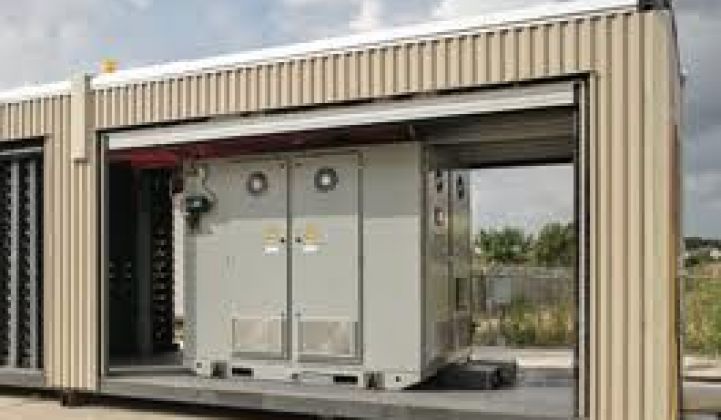Battery startup Xtreme Power’s move to sell off its battery manufacturing plant and stay afloat as a provider of grid-scale energy storage software and integration expertise hasn’t panned out.
Now we’ll see if bankruptcy, and potential takeover by a creditor, can keep the company’s megawatt-scale energy storage pipeline flowing, or whether it will screech to a halt.
On Thursday, the Lyle, Texas-based company filed for Chapter 11 bankruptcy protection in the U.S. Bankruptcy Court for the Western District of Texas. Xtreme plans to “continue its operations at all locations as it begins a process to identify an acquirer,” according to Thursday’s statement, with general creditors providing financing. The company's core engineering, project development and operations staff will remain in place during this process.
CEO Alan Gotcher stated that the bankruptcy filing has been “structured to allow one of the company's creditors to file a stalking-horse bid” if competing bids don't emerge by the end of February. He added that Xtreme has a pipeline of business in excess of $100 million and letters of intent for another $65 million of new business, and projects earnings before interest, taxes, depreciation and amortization (EBITDA) would reach break-even later this year.
At the same time, Xtreme’s statement noted that it has deployed about 60 megawatts of its decades-old advanced lead-acid battery technology in twelve projects around the world. That figure is smaller than the 77 megawatts of batteries in fourteen projects it said were deployed or in progress as of mid-2013, and indicates that Xtreme may have had some projects delayed or canceled because of its financial struggles.
Those struggles have been on public display since April 2013, when Xtreme announced plans to sell the Oklahoma-based factory where it makes its solid-state, advanced lead-acid PowerCell batteries, and concentrate instead on software and services to integrate grid-scale energy storage projects using other partners’ batteries. UPDATE: An Xtreme spokeswoman informed us that this factory has not been sold, and will be part of bankruptcy reorganization of the company.
In simple terms, it appears that Xtreme has fallen prey to the same difficulties that have driven other battery makers to bankruptcy as they’ve sought to compete in an international marketplace dominated by established manufacturers, largely based in Asia. That list includes new entrants like A123 Systems and Ener1, as well as long-time players like Exide and International Battery.
Xtreme does have significant deployments in the still-nascent field of grid-scale energy storage, including the largest battery-based project in the United States, a 36-megawatt, 24-megawatt-hour system sited at Duke Energy’s Notrees, Texas wind farm. But it’s also seen its share of problems, including a 2012 fire that destroyed its 15-megawatt energy storage facility in Hawaii.
On the battery management software front, Xtreme had announced several partners that planned to work with it, including General Electric for its sodium-metal Durathon batteries, and Samsung SDI for its grid-scale lithium-ion batteries. But it’s unclear how those relationships have been proceeding. GE, for one, declined to comment in November on how, or whether, it was working with Xtreme to deploy its Durathon batteries.
Bankruptcy doesn’t necessarily spell doom for Xtreme’s battery technology or its software and systems integration businesses. The example of A123, which is seeking to revive its business in both grid-scale and automotive battery projects under new owner Wanxiang Group, provides one hopeful example.
Michael Breen, a co-founder of Xtreme who left the company in 2011, told me in an October interview that Xtreme’s battery management and grid integration software were “built for our battery and our inverter," which made sense for its goal of becoming a battery provider in its own right. But like most of the custom-built, engineered grid-scale energy storage projects out there today, it required quite a bit of hands-on work to alter its usage to meet grid purposes not originally envisioned -- "Any time you wanted to change it, it was more than a simple exercise.”
Breen has since become CEO of Growing Energy Labs (GELI), a startup developing energy storage management software for use with a wide variety of batteries and power electronics for a multitude of use cases, largely on the customer side of the grid. That’s a much less capital-intensive approach to the energy storage market for a startup, compared to raising the money and securing the financing to support full-scale battery manufacturing.
Xtreme has raised about $55.7 million since it was founded in 2004, with investors including SAIL Capital Partners, Bessemer Venture Partners, The Dow Chemical Company, Fluor Corp., BP Alternative Energy, Dominion Resources, POSCO ICT, Skylake & Co. and Spring Ventures, LLC. The company has retained Gordian Group LLC to assist in its plan to find a creditor to buy it out of bankruptcy proceedings.



